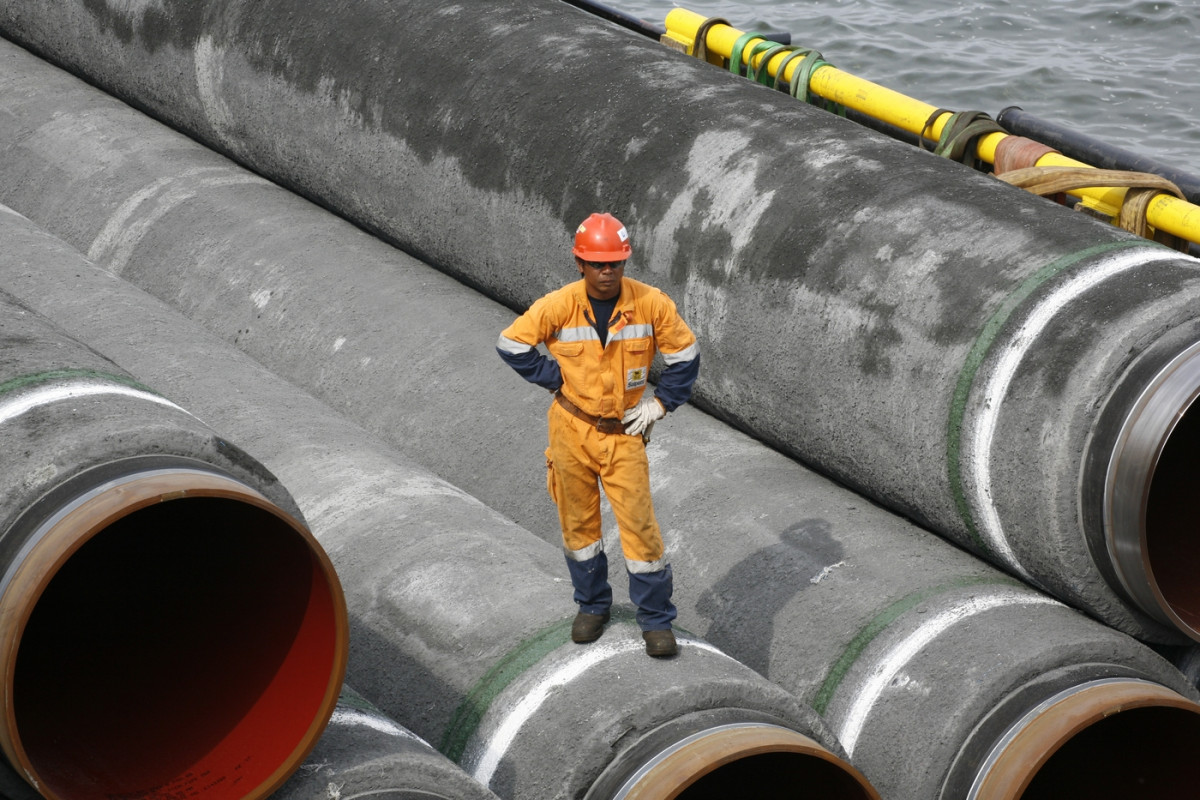Charlotte Nijhuis23 Feb 2021, 11:11

Photo: Nord Stream AG
The pipeline
Nord Stream 2 would connect Germany directly to Russian gas supply, but it has split opinions in Europe and beyond for years. The tube's construction in the Baltic Sea is well advanced, but the project dampens efforts to rekindle good transatlantic relations, as the US is strongly opposed to the project and has imposed sanctions on the companies involved. This article provides a chronological overview of the twists and turns surrounding the project and will be updated regularly. [UPDATES to 23 February]
For background on the project, including arguments from proponents and opponents of the pipeline, see
our factsheet.
Recent developments
German, U.S. and international media such as
Handelsblatt,
Wall Street Journal and the
Financial Times reported in mid-February that the administration of new President Joe Biden might be willing to make a deal with Germany on
Nord Stream 2, according to government sources. It remained unclear whether Biden would even consider to do so in the face of clear bipartisan opposition in the U.S. Congress. A deal could involve waiving sanctions in turn for an agreement that Germany would shut off future natural gas deliveries through the pipeline, for example in case Russia put pressure on Ukraine.
After more than a year of threatening to do so, the U.S. had introduced first sanctions on 19 January, former president Donald Trump’s final full day in office. The administration sanctioned the Russian ship Fortuna, which later resumed pipe-laying in Danish waters on 6 February.
The pipeline was originally scheduled for completion by the end of 2019. About 2,300 km out of approximately 2,460 km
had been laid by December 2019, when Swiss pipelaying company Allseas suspended activity following the introduction of U.S. sanctions legislation. By mid-February 2021, about 150 km – 75 km per strand of the twin pipeline – still had to be completed, mostly in Danish and to some extent in German waters.
Timeline2021
23 February: Eighteen European companies have withdrawn or are in the process of
withdrawing from the pipeline project following U.S. sanctions threats, according to a U.S. state department report for Congress submitted on Friday (19 February). "This shows that the legislative goals and our actions have been successful," U.S. state department spokesman Ned Price said. "We continue to monitor companies involved in potentially sanctionable acts."
22 February 2021: Polish foreign minister Zbigniew Rau and Ukrainian foreign minister Dmytro Kuleba
call for an end to Nord Stream 2, as it damages the “strong, vibrant and resilient West”, the ministers write in an opinion piece published by Politico. The United States can play an important role in preventing the completion of the pipeline, the ministers say.
20 February 2021: The Biden administration
singles out a Russian ship for violating U.S. sanctions on the construction of the pipeline, Bloomberg reports. Like in the first round, the U.S. sanctions the ship Fortuna. Not sanctioning German entities involved can be seen as reflecting reported decisions by the new administration not to challenge Germany over its support for the pipeline, in an effort not to antagonise a key European ally.
19 February 2021: The U.S. might hold off on sanctioning German companies involved in the
Nord Stream 2 project, as the Biden administration seeks to halt the project without antagonizing a close European ally, Bloomberg
reports. It would instead put only a small number of Russia-linked entities on the list.
16 February 2021: The Biden administration
might be willing to make a deal with Berlin on
Nord Stream 2, according to German media sources. However, it remains unclear whether Biden would even consider doing so in the face of clear bipartisan opposition in the U.S. Congress. A deal could involve waiving sanctions in exchange for an agreement that Germany would stop future natural gas deliveries through the pipeline, for example in case Russia puts pressure on Ukraine.
9 February 2021: German environmental NGO Umwelthilfe
publishes a letter written by German finance minister Olaf Scholz to former U.S. counterpart Steven Mnuchin. In the letter, dated 7 August 2020 and
reported by Zeit in September 2020, Germany offers financial support for German liquid natural gas (LNG) importers to enable them to directly import U.S. LNG in a bid to prevent the U.S. from imposing sanctions on the
Nord Stream 2 pipeline.
9 February 2021: German president Frank-Walter Steinmeier
defends the pipeline by pointing at the "bigger picture", including Germany's invasion of the Soviet Union during WWII, in
an interview with German newspaper Rheinische Post. The presidents' comments leave Ukraine angry as they ignore the Ukrainian victims of the war. The Ukrainian ambassador says the president's stance was met with "surprise and indignation" in Kyiv.
6 February 2021: The construction of the pipeline with the Russian vessel Fortuna
restarts in Danish waters despite U.S. sanctions.
1 February 2021: France
urges Germany to drop the Nord Stream 2 project in light of the arrest of Russian opposition leader Alexei Navalny.
21 January 2021: The European Parliament
calls for a halt to Nord Stream 2 after the arrest of Russian opposition leader Alexei Navalny. On the same day,
Merkel reaffirms her support for Nord Stream 2, despite growing opposition in Germany and the EU. “My basic attitude has not yet changed to the point where I say the project should not exist,” Merkel says at a press conference in Berlin.
19 January 2021: The U.S. announces
sanctions for the first time – on the Russian pipe laying vessel Fortuna. The German government says it “notes” the decision “with regret.” Previously, there had only been a threat of sanctions.
15 January 2021:
Nord Stream 2 receives a
renewed construction permit from Germany’s Federal Maritime and Hydrographic Agency (BSH) for a short stretch in German waters after the original permit had run out. Rresearchers from the German Institute for Economic Research (
DIW) question whether Germany needs the pipeline for its natural gas supply.
6 January 2021: The parliament of the German federal state of Mecklenburg-Western Pomerania, where the
Nord Stream 2 pipeline would land,
sets up a “climate” foundation in an effort to circumvent the threat of U.S. sanctions. To justify its purpose of finalising
Nord Stream 2, the pipeline is highlighted as a special contribution to energy security and a source of natural gas, the energy transition’s "bridging technology.” Environmentalists criticise the plans and say they will fuel the climate crisis. German political analyst Thomas O'Donnell of the Hertie School of Governance says
the plan is unlikely to work, as “no company […] will sell equipment to this foundation.”
1 January 2021: The U.S. Congress
authorises new sanctions against companies involved in the construction of the pipeline.
202028 December 2020: The Russian pipe laying vessel
Fortuna leaves the Nord Stream 2 construction site in the Baltic Sea, indicating that the construction in German waters may have been completed.
11 December 2020: The pipeline’s construction
continues with the Russian pipe laying vessel Fortuna, which completes a short 2.6 km stretch in German waters.
30 November 2020: Certification company DNV-GL
suspends certification work for vessels involved in the pipeline project citing possible sanctions under the Protecting Europe's Energy Security Act (
PEESA) as the reason.
23 November 2020: The U.S.
increases pressure on people and companies associated with the construction of the pipeline and its leaders make several direct phone calls. "We are making these calls to warn them and give them time to get out," said a U.S. administration representative.
4 September 2020: Several members of the European Parliament
call on EU and member state officials to "do whatever they can to stop the completion of the
Nord Stream 2 pipeline now."
3 September 2020: German politicians
call for halt to the Nord Stream 2 project following the poisoning of Alexei Navalny. Norbert Röttgen, a lawmaker with German chancellor Angela Merkel’s conservative Christian Democratic Union (
CDU), calls for a “clear European response” and says “diplomatic rituals” would no longer suffice as a reaction to Russia’s “inhumane politics.”
28 August 2020: The poisoning of Alexei Navalny and the completion of the natural gas pipeline are “separate issues,” and linking them would “not be appropriate,” German chancellor Angela
Merkel says during her annual press conference in Berlin. Navalny was treated a hospital in Germany earlier in the month after being poisoned in Russia.
12 August 2020: Utility company
Uniper, one of the investors in the
Nord Stream 2 project, publishes a report saying
the pipeline could be delayed or even fail altogether due to the threat of U.S. sanctions.
7 August 2020: Three Republican senators threaten that
the U.S. will impose "crushing legal and economic sanctions" on the port of Sassnitz on the German Baltic Sea, a key hub for the
Nord Stream 2 pipeline.
5 August 2020: Environmental Action Germany (
DUH) says it is
suing to stop Nord Stream 2 from going into operation over methane leakage concerns.
30 July 2020: The companies involved in
Nord Stream 2 call for political support against the possibility of U.S. sanctions.
15 July 2020: The U.S.
threatens investors to ditch
Nord Stream 2. It is meant as a “clear warning” to companies that aiding the project would not be tolerated by Washington. “Get out now, or risk the consequences,” secretary of state Mike Pompeo said.
18 June 2020: All parties in the German parliament reject the economic sanctions threatened by the U.S. In a
statement released by parliament's economy and energy committee, the MPs said that "there has been solid cross-party unanimity that these extraterritorial sanctions are in violation of international law and cannot be accepted."
8 June 2020: German officials
condemn U.S. plans to expand NS2 sanctions, shortly after several U.S. senators, including Ted Cruz (Republican) and Jeanne Shaheen (Democrat) presented a bill that would expand existing sanctions and penalise all companies involved in the project.
May 2020: Russia defies threats from the U.S. and
deploys a new vessel to finish the construction of
Nord Stream 2. The vessel, Akademik Cherskiy, replaces a ship provided by Swiss company Allseas, which was withdrawn from the construction in December 2019 following U.S. threats.
19 February 2020: German economy minister Peter Altmaier criticises the
Nord Stream 2 sanctions and says
the importance of Russian gas for Germany is set to grow further amid the German energy transition. Altmaier says he regrets the decision by the U.S. to impose sanctions and stresses that Germany is going to "need more natural gas, not less" as it phases out coal-fired power production over the next years.
11 January 2020:
Nord Stream 2 could be finished by the end of 2020 or the first quarter of 2021, Russian president Vladimir Putin says during a
press conference, following a meeting with German chancellor Angela Merkel in Moscow.
201930 December 2019: Russian and Ukrainian companies
sign a final five-year agreement safeguarding Russian gas transit to Europe via Ukraine.
21 December 2019: The Swiss offshore contractor
Allseas suspends its Nord Stream 2 pipe-laying activities, anticipating the enactment of the U.S. sanctions as President Donald Trump signs legislation. The move effectively halts construction for about a year.
19 December 2019: German chancellor Angela Merkel
criticises the U.S. sanctions to be imposed on companies working on
Nord Stream 2, shortly after the relevant legislation was approved by the U.S. Senate. “We are opposed to extraterritorial sanctions,” Merkel said during question time in the national parliament.
8 February 2019: EU member states
agree to a last-ditch deal struck by France and Germany that introduces tougher requirements for the
Nord Stream 2 pipeline, but does not endanger the project as a whole.
January 2019: The U.S. ambassador to Germany, Richard Grenell,
writes letters to companies involved in the construction of
Nord Stream 2, urging them to stop working on the project and threatening them with the possibility of sanctions.
20184 December 2018: German foreign minister Heiko Maas says
Germany will not withdraw its political support for Nord Stream 2, despite tensions between Ukraine and Russia.
14 November 2018: The U.S. ambassador to the EU, Gordon Sondland,
threatens sanctions on Nord Stream 2 and says the U.S. has “not deployed the full set of tools yet” to thwart the completion of the pipeline.
24 October 2018: Polish president Andrzej Duda
calls for a stop to Nord Stream 2 during a visit to Germany, arguing that it would upset the “energy balance.”
19 September 2018: Germany says it will
choose a location for its first liquefied natural gas (LNG) terminal by the end of the year as a gesture to the U.S., which wants to ship more gas to Europe. (By February 2021, there was still no final investment decision on a domestic German LNG terminal)
30 August 2018: Construction of
Nord Stream 2 begins in German waters. 21 August 2018: Russia says it is ready to
defy “illegal” U.S. sanctions against
Nord Stream 2, as the U.S. administration reiterates its threat to impose sanctions on companies involved in the project.
18 August 2018: Russian President Vladimir Putin and German chancellor Angela Merkel meet near Berlin to
discuss issues surrounding Nord Stream 2, including the possible disadvantages for Ukraine. Merkel reiterates that “Ukraine has to play a role also with
Nord Stream 2 in place.”
17 July 2018: Ministerial discussions between Ukraine, Russia and the EU regarding the future delivery of Russian gas to Western Europe via
Nord Stream 2 begin in Berlin.
11 July 2018: US president Donald Trump
lashes out at Nord Stream 2 and says Germany is “totally controlled by” and “captive of” Russia, as the natural gas pipeline will increase Germany’s reliance on Russian energy resources.
18 May 2018: Ukrainian president Petro Poroshenko says the
Nord Stream 2 project
would empower Moscow to “attack our common values” and the pipeline would be “a tragic historic mistake.”
15 May 2018: German economy and energy minister Peter Altmaier
calls on Russia to guarantee the continued transmission of natural gas via Ukraine after the completion of
Nord Stream 2.
11 April 2018: German chancellor Merkel
says that Ukraine must not be excluded from
Nord Stream 2, thereby intervening in the dispute between Russia and Ukraine.
28 March 2018: With the Federal Maritime and Hydrographic Agency (BSH),
the last German authority approves the construction and operation of
Nord Stream 2.
31 January 2018: Germany
grants Nord Stream 2 a permit for construction and operation in German waters and landfall areas near Lubmin.
2017
15 December 2017: German authorities
issue the first partial permit for
Nord Stream 2 construction in the Baltic Sea.
25 April 2017: To find an alternative way to get the project going,
Uniper, Wintershall, ENGIE, OMV and Royal Dutch Shell
sign a financing agreement with
Nord Stream 2 AG, a subsidiary of Gazprom responsible for the development of the
Nord Stream 2 project.
201612 August 2016: Gazprom’s partners ENGIE, Gazprom, OMV, Shell,
Uniper and Wintershall
withdraw their application for merger approval from the Polish competition authority for
Nord Stream 2. Gazprom says the withdrawal will not affect the construction of the pipeline.
7 March 2016: Eight EU leaders sign a letter
objecting to Nord Stream 2 citing geopolitical reasons.
2015June 2015: Gazprom, Royal Dutch Shell,
E.ON, OMV and ENGIE
sign an agreement to build
Nord Stream 2.
All texts created by the Clean Energy Wire are available under a “Creative Commons Attribution 4.0 International Licence (CC BY 4.0)” . They can be copied, shared and made publicly accessible by users so long as they give appropriate credit, provide a link to the license, and indicate if changes were made.







 © THE CANADIAN PRESS/Carlos Osorio Black Lives Matter protesters threw pink paint on a statue of Egerton Ryerson at Ryerson University in Toronto on July 18, 2020.
© THE CANADIAN PRESS/Carlos Osorio Black Lives Matter protesters threw pink paint on a statue of Egerton Ryerson at Ryerson University in Toronto on July 18, 2020.



